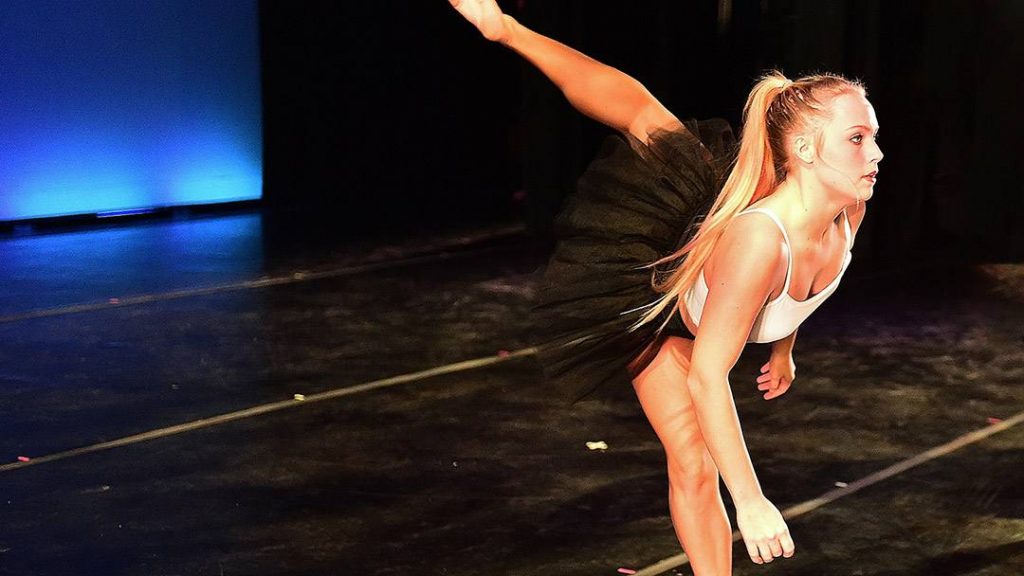
When a cavernous malformation was discovered in her brain, Allison Nilsen turned to Mayo Clinic for answers. The care and treatment she's received at Mayo has allowed her to complete her college degree and continue doing what she loves.
Allison Nilsen has been dancing since she was 2 years old. And despite being diagnosed with a rare medical condition known as a cavernous malformation, she's not planning to stop any time soon.
Cavernous malformations are abnormally formed blood vessels that can leak blood and cause bleeding. When they grow in the brain or spinal cord, symptoms may include weakness, numbness, difficulty speaking, severe headaches, vision changes and seizures.
When Allison found out that she had a large cavernous malformation in her brain, she thought she may need neurosurgery, and she learned the procedure could significantly affect her ability to dance. Working with a care team at Mayo Clinic, however, Allison found another way forward that has allowed her to continue pursuing her passion.
Mounting concern
When Allison graduated from high school in Chesapeake, Virginia, in 2012, she decided to take a gap year before heading off to college. During that time, she planned to keep dancing with a company that she had performed and competed with in the past.
But health concerns began to interfere with those plans. Allison had been having terrible migraines for two years. During the year after her graduation, the headaches were so severe that they landed her in the emergency department half a dozen times.
Then while practicing for a dance competition in spring 2013, Allison noticed a problem with her right foot. "It felt like it couldn't keep up with my left foot," she says.
Allison and her mom, Teresa, shared that development with the local neurologist Allison had been seeing for her migraines. The neurologist recommended an MRI. Soon after Allison had the MRI, Teresa received a call from the neurologist directing her to take Allison to the emergency department immediately. The MRI imaging had revealed a cavernous malformation the size of a golf ball in Allison's brain. The malformation was sitting on the motor strip that controls her right foot. It had bled and caused the weakness in that foot.
Weighing the options
At the time of her diagnosis, Allison had received a dance scholarship to Jacksonville University and planned to move to Florida, so she began researching specialists in that area. She found James Meschia, M.D., a neurologist at Mayo Clinic in Florida and made an appointment to see him.
During a consult in July 2013, Dr. Meschia evaluated Allison's condition. He told her that treatment for cavernous malformation involved surgery — specifically a procedure known as awake craniotomy. Dr. Meschia prescribed Allison an anti-seizure medication and referred her to Mayo Clinic neurosurgeon Rabih Tawk, M.D.
During her appointment with Dr. Tawk, Allison shared her love of dancing and strong desire to complete her fine arts degree. He listened to her concerns and then explained that, while the risk of the malformation bleeding again was between 1% and 6% a year, it was possible to live with the condition for years. Dr. Tawk also indicated that surgically removing malformations isn't always the best solution for every patient, and he believed that may be true in Allison's case.
"(Dr. Tawk) is a good person with genuine concern. I could tell that he truly understood the impact a surgery could have on me and my dance career."
Allison Nilsen
"After looking at new imaging, I didn't feel like the malformation had bled significantly or increased in size," Dr. Tawk says. "Because the deficit to her foot was so minor, we had to weigh the risk that surgery could potentially affect her ability to perform."
Allison appreciated his thoughtful consideration of the effect the surgery might have on her. "Dr. Tawk is so thorough. He answers all your questions and doesn't talk down to you," she says. "He is a good person with genuine concern. I could tell that he truly understood the impact a surgery could have on me and my dance career."
Taking such individual circumstances into account is part of the process, according to Dr. Tawk. "Feeling your patient's pain, and sharing their experience and pain is important," he says. "You have to think about a patient like your own family."
Seizing the opportunities

Based on their discussions with Dr. Tawk, Allison and her mom decided against moving forward with surgery at that time. Instead, they opted for Allison to be followed closely with imaging until she finished college. Since then, that plan has served her well.
In 2017, Allison graduated from Jacksonville University with a Bachelor of Fine Arts degree in dance. Although she still takes medication for migraines, Allison hasn't had any further symptoms from the cavernous malformation, and surgery hasn't been necessary.
Today, Allison is happily continuing her dance career and indulging in other creative pursuits. She teaches dance at a studio in Jacksonville and sells her original paintings online. Her dream is to open her own dance studio one day. She's thankful for all the opportunities she has to continue doing what she loves.
"I think that when something devastating happens, it makes you appreciate everything more," Allison says. "I'm grateful that I'm here and am taking advantage of whatever time I have before I need to have surgery — to teach, perform and enjoy my life."
HELPFUL LINKS
- Read more about cavernous malformations.
- Learn about Mayo Clinic's Department of Neurosurgery.
- Connect with others talking about cerebrovascular diseases on Mayo Clinic Connect.
- Explore Mayo Clinic in Florida.
- Request an appointment.







